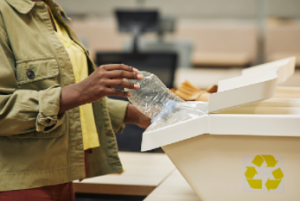Understanding the Concept of Bottle Recycling
There are several benefits to bottle recycling. First, the bottles are used for various purposes, such as playground equipment, carpeting, durable backyard decks, and more. Caps and plastic bottles can also be recycled into tough kitchen bowls, car battery cases, and toothbrush cases. They can even be used as storage bins. But what happens to all those plastic bottles when they’re not being used? You’ll be surprised by the solutions available.
 Plastic bottles are sold
Plastic bottles are sold
There are many benefits of bottle recycling storehouse. Firstly, it reduces the amount of plastic waste thrown into landfills. Secondly, it creates new jobs for people who collect recyclables and those who work in bottle recycling facilities. Thirdly, it helps save our environment from pollution. Plastic bottles can be recycled to make other products, such as water bottles. Here are a few examples of these uses. In addition, recycle your water bottles instead of trashing them, and you’ll be doing your part for the environment.
One way to make money by upcycling plastic bottles is by selling them for bottle recycling. Many sites offer step-by-step tutorials on how to recycle plastic bottles. While most of the plastic bottles we use are eventually thrown away, you can use them to create unique products to sell for profit. Your location depends on whether you sell these recycled bottles to a bottle recycling company. You can also sell them to other companies.
In 2016, less than half of all bottles purchased were recycled, and only 7% of them were made into new bottles. As a result, most plastic bottles end up in landfills or the ocean. Every year, five to thirteen million tonnes of plastic leak into the ocean. These plastics are consumed by marine life and are found in the oceans. By 2050, oceans will have more plastic than fish – and some of this plastic is already in the human food chain.
They are shipped
In the U.S., the demand for recycled plastic bottles has increased steadily in recent years to meet ambitious state and company goals. But, in the meantime, the county’s recycling rates have remained flat or have declined in recent years. Even though there’s been an increase in recycled plastic, the recycling rate has remained low for decades. It declined by one percentage point in 2019.
Recycling relies on consumer goodwill in much of the country, but millions of bottles and cans end up in landfills each year despite this convenience. There’s a growing concern that expanding these bottle bills will cost the beverage industry billions of dollars. The beverage industry says that the bills act like a tax, and they’re already paying handling fees for the empty bottles and cans. However, this argument doesn’t make sense if the industry is in such a position to make such an investment.
The vast majority of the bottle and can recycling occurs at Materials Recovery Facilities (MRFs). These facilities collect and sort recycled bottles and cans. Then, the materials are sent to recyclers using conveyor belts or sorters. The aluminium cans, for instance, are recycled into new aluminium cans, while the steel cans and glass jars are recycled into bicycles, beams, and other products. By contrast, the glass jars and bottles are sent to recycling facilities to become new bottles.
They are melted
Most plastic bottles are recyclable, but only about 30% are. It is because the resin used to make plastic bottles, PET, degrades with time. Recycling PET produces wood or fibre replacements, but manufacturers must add virgin plastics to achieve the same quality. As a result, in the U.S., less than 30% of plastic bottles are recycled. Downcycling, on the other hand, cuts the item’s life cycle in half. The resulting materials end up in landfills or incinerators.
The first step in bottle recycling is to separate the glass’s components. These components are what make glass unique. Green and brown coloured bottles cannot be recycled. These substances must be separated and recycled separately. Once separated, these materials are melted at lower temperatures than new glass. Once melted, the glass will be poured into a mould to create new bottles or glasses. This process requires about five hours. It’s important to remember that plastic bottles can contain up to 45% more material than new glass.